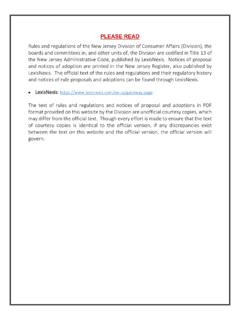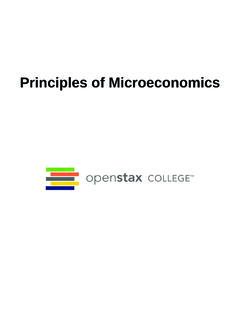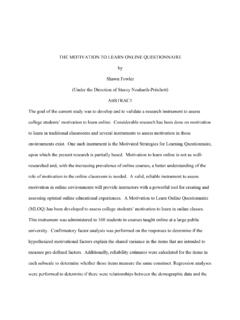Transcription of 2017 - Home | Milken Institute
1 Sindhu Kubendran and Liana SollIntroduction by Paul Irving2 017 About the Center for the Future of AgingThe mission of the Milken Institute Center for the Future of Aging is to improve lives and strengthen societies by promoting healthy, productive and purposeful aging. @MIAging @MilkenCFA Future of Aging want to thank the authors of the 2017 Best Cities for Successful Aging report and index, Sindhu Kubendran and Liana Soll. By informing and educating civic leaders and the public, they are improving lives in cities across America. I share their appreciation for the data collection and research assistance of Maricruz Arteaga-Garavito as well as for the time and expertise of Jennifer Ailshire and Moosa Azadian of the University of Southern California. I m grateful for the talents of our friend and project collaborator Rita Beamish, the sharp editorial eye of our colleague Edward Silver, and the visual acumen of our designer, Jane Lee.
2 I appreciate Cheryl Murphy for her help in our Mayor s Pledge campaign, Jill Posnick, Bridget Wiegman, and Tulasi Lovell for their communications support, and assistants Shantika Maharaj and Fran Campione. Milken Institute researchers Ross DeVol and Perry Wong, along with fellow Anusuya Chatterjee, continue to support and contribute to the success of our Best Cities mission. Last, but certainly not least, thanks to Vivian Vasallo, Arielle Burstein, Sophie Okolo, and the members of the Center for the Future of Aging Advisory Board for their ideas and insights. We re proud of our association with each of IrvingChairman, Milken Institute Center for the Future of AgingAbout the Milken InstituteThe Milken Institute is a nonprofit , nonpartisan think tank determined to increase global prosperity by advancing collaborative solutions that widen access to capital, create jobs, and improve health. We do this through independent, data-driven research, action-oriented meetings, and meaningful policy initiatives.
3 2017 Milken Institute . This work is made available under the terms of the Creative Commons Attribution-NonCommercial-NoDerivs Unported License, available at 6 Top 20 Large Metros 14 Top 20 Small Metros 28 Programs With Purpose 42 Initiatives for Innovation 48 Mayor s Pledge 52 Methodology 56 Rankings for All Metros 69 Board of Advisors 79 About the Authors 802 017 Sindhu Kubendran and Liana SollIntroduction by Paul Irving4 Age-friendly environments improve quality of life for all. They foster well-being and hold back age-associated decline. 5In a time when lives are extending into eight, nine, and even 10 decades, yesterday s notion of idling away our later years is fading. While the health and economic challenges of aging remain significant concerns, an increasing number of today s older adults are rede-fining the experience. They are launching companies and nonprofits, climbing mountains, creating apps, and mentoring youth.
4 They increasingly seek lifelong engage-ment and purpose. They expect their communities to support their changing needs, recognize their abilities, and enable their contributions to the greater good. With the gift of longevity, new opportunities have emerged for older adults to pursue work and educa-tion, social and civic involvement, and rich interaction with younger people and one another. At the same time, this fast-growing cohort wants better health care and increased financial security. They seek access to amenities that ease the challenges of aging and enhance quality of life for themselves and their loved ones. In our individual and collective efforts to achieve these goals, where we live has never been more in mind this evolving 21st-century profile of older Americans, the Milken Institute Center for the Future of Aging, in collaboration with the Institute s Research Department, presents the 2017 Best Cities for Successful Aging report and index.
5 This third edition of our groundbreaking series methodically evaluates metropolitan areas on how well they serve the needs and meet the expectations of the nation s largest-ever population of mature adults, enabling them to age productively, securely, and in optimal health. In the pages that follow, we rank 381 metropolitan areas, using refined methodology and updated data in nine categories. Our aim is to help people fulfill the potential of their later years, a potential that, research tells us, can immensely benefit not just older adults but individuals across the age spectrum and the broader society as well. As we create better cities for older adults, we create communities that are livable for people of all a rankings system? By stirring virtuous competi-tion, we hope to galvanize improvement in the social structures that serve a growing urban population. We want to encourage best practices and innovation along with solutions-focused dialogue among thought leaders, decision-makers, and stakeholders.
6 Older people and the environments in which they live are diverse, dynamic and changing; in interaction, they hold incredible potential for enabling or constraining healthy ageing. WORLD HEALTH ORGANIZATIONINTRODUCTIONBY PAUL IRVINGC hairman, Milken Institute Center for the Future of Aging6 GENERALLIVABILITYFINANCIALSECURITYCOMMUN ITYENGAGEMENTTRANSPORTATIONAND CONVENIENCEEDUCATIONHEALTH CAREWELLNESSLIVINGARRANGEMENTSEMPLOYMENT We include 83 indicators from publicly available data on criteria that experts commonly cite as important to age-friendly environments WHAT MAKES A BEST CITY?A Timely FocusFour important realities underpin our focus on aging in metropolitan areas: As is the case across much of the world, the population is aging at an unprecedented pace. Demographers project that one in five Americans will be 65 or over by 2030 as the nearly 80 million baby boomers age. Older people want to age in place.
7 AARP surveys find that the vast majority of people including nearly nine in 10 of those 65 and older do not plan to pack up and move to the Sun Belt but want to age in their current homes and communities. The number of older residents in metropolitan areas is expanding. Globally, the World Health Organization anticipates that by 2030, about three of every five people will live in cities, a large segment of them over age 60. In the , 80 percent of people 65 and older already live in metropolitan areas large and small, according to the Department of Health and Human Services. Longevity is linked to location. Put simply, life expectancy differs significantly depending on where people live. Not everyone is sharing in the benefits of longer lives. A widening longevity gap, including within cities, highlights the need to ensure that health and prosperity are spread. The variation is tied to factors that include education, income, access to health care, food choices, smoking rates, exercise, safety of housing, and residents deserve a chance to thrive, and age-friendly environments improve quality of life for all.
8 They foster well-being and hold back age-associated decline. When communities enable aging adults to work, learn, volunteer, and participate socially and economically, the benefits accrue to younger people and the broader society as the twin trends of urban living and shifting demography and the positive change within our reach, the pursuit of healthy, productive, and purposeful aging must become a priority for civic leaders. With the continuing partisanship and discord at the federal level, the nation s cities are poised to lead, serving as incubators of innovation in response to the new realities. Will they step up to the task? This is the challenge that Best Cities seeks to Than a SnapshotOur Best Cities index goes deeper than the many top 10 retirement lists based on opinion surveys and rankings that often rely on just a few characteristics like weather or living costs. These factors are only part of the complex infrastructure and social context that affect health, productivity, and purpose as people age.
9 Indeed, Best Cities for Successful Aging is not about the best places to retire. To the contrary, it offers a broad focus on livability across the life course. Our research staff, with the input of our Center for the Future of Aging Board of Advisors, employs a weighted, multidimensional methodology based on a range of Demographers project that one in five Americans will be 65 or over by 2030 as the nearly 80 million baby boomers NEW OLD Longevity is linked to location. Put simply, life expectancy differs significantly depending on where people live, with the variation tied to factors like education, income, access to health care, food choices, smoking rates, exercise, safety of housing, and that influence aging. We use indicators from publicly available data that reflect key characteristics commonly cited by experts as important to age-friendly environments: Safety, living options, and affordability. We analyze statistics on cost of living, homeownership and rental costs, employment, crime rates, income distribution, and weather, as well as nursing homes, assisted living facilities, and home health-care providers.
10 Health and wellness. We look at access to high-quality health care by measuring the number of health professionals, hospital beds, long-term hospitals, and facilities with geriatric, Alzheimer s, dialysis, hospice, and rehabilitation services, as well as hospital quality and affiliation with medical schools. We examine health behaviors and outcomes in terms of obesity, diabetes, Alzheimer s, smoking, and mental health. The avail-ability of recreation, wellness programs, and other healthy pursuits are also part of the equation. Financial security, work, and entrepreneurship opportunities. We look at tax burden, small- business growth, employment opportunities and rates for those 65 and over, poverty, and the number of reverse mortgages. Mobility, transportation access, and convenience. We review commute times, fares, the use of and invest-ment in public transit, especially for older residents, and the number of grocery stores.






![[NEW] ACR Practice Guideline for Imaging Pregnant or ...](/cache/preview/e/a/8/4/b/0/1/9/thumb-ea84b019372f84852417227f519bc50d.jpg)


